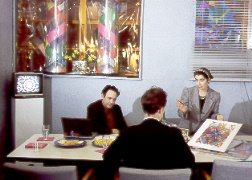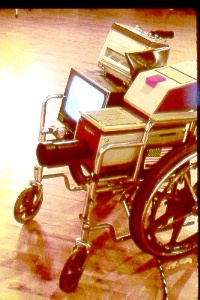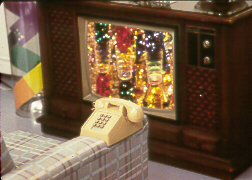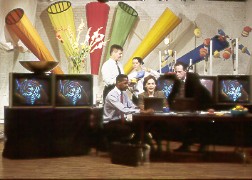The Museum Gazeteer
New York's museums offer a wealth of experience for visitors of all ages and several encyclopedias worth of information. While some (like the Metropolitan Museum of Art, the American Museum of Natural History and the Museum of Modern Art) are world-famous, there are also smaller, more specialized institutions which amply reward the visitor who searches them out. The Gazeteer will profile a different museum periodically, focusing on what makes it worth a visit. Yes, we'll get around to the big, blockbuster institutions in Manhattan eventually, but we'll start with some of the smaller museums that stand, waiting to welcome, entertain--and perhaps even educate--you in almost every neighborhood and suburb.
OF HANDMADE VIDEO ART AND VIDEO DANCE
William and Kathleen Laziza offer multimedia dances, visual music, moving paintings, a kinetic loveseat, a robot named "Great Auntie Mame" and more.
December 6 to 12
Promote Art Works, Inc., 123 Smith Street, Brooklyn
Public showings at 5:00 pm and 7:00 pm each day
Admission $20 adults, $5 students, advance ticketing required.
Tickets & info 718-797-3116
The format is a two-hour guided tour, allowing a certain amount of time for each attraction.
Museum is open December 1 to 20 for private parties under 30.
December 10: Gala performance of "Pursuit of Happenstance" (see below) at 5:00 pm and 7:00 pm, $50.
Museum exhibition will be open by appointment through June, 1999.
A Micro Museum grows in Brooklyn. With the diaspora of artists to the outer boroughs, it was natural that "boutique" museums should spring up in new neighborhoods, enlivening the environs with innovative art forms. "The Micro Museum Exhibit" by William and Kathleen Laziza is dedicated pretty much to video art, for which there's really no "natural" home in Manhattan (unless, perhaps, the Museum of Broadcasting). So why not Boerum Hill in Brooklyn?

| |
| William and Kathleen Laziza in Micro Museum Office, with a visitor. Behind them, in the windows, are solar-driven kinetic sculptures. | |
"The Micro Museum Exhibit" is a multimedia installation of videoart and videodance created entirely by the two Lazizas. It features world premieres of "Circles to Infinity," a videodance by Laziza Electrique Dance Company and "Flash in the Pan," an abstract videoart piece by William Laziza with music composed by Joseph Jarman. The exhibition also includes a flock of humorous, user-interactive, kinetic sculptures by William and Kathleen Laziza, including solar powered kinetic sculpture, video dances, moving paintings, a loveseat which projects lights interactively and a chair that weighs you and jokes about your weight. Available to school groups will be an interactive participatory light show that uses the audience as shadow puppeteers. Whereas most museums are sternly "hands off!" experiences, The Micro Museum Exhibit is emphatically "hands on!".
The environment of The Micro Museum is broken into two rooms, a small one and a large one. The smaller room is like a small New York studio apartment and contains the attractions that comment on living: "3D-TV," "Phone-i-ture," "Sky Lamp," and "Invalid TV." The large room is a video viewing room and performance area.

| |
| "Great Auntie Mame," a robot instrument which works on positive feedback, used in "Flash in the Pan" and "Invalid TV" | |
SKY LAMP -- A TorchiŽre (pole) Lamp has a mobile attached overhead that turns with the heat of the bulb and modulates the light to create variable tints on the ceiling. As it changes from rose to yellow to blue, it changes your mood. Brass keys hanging from the mobile act as a chime and there is shadow play as onlookers can move the keys interactively.
MOVIEOLA -- A participatory light show in a studio where the audience watches an 8' x 10' screen and participants engage in shadow-play behind the screen. The pattern of the participants is that they move in a circular vietrope, like an old movieola. The effect is that participants move without concern for how the audience sees them. Kids love it. (Available by appointment for school groups.)
WEIGHING IN -- A talking chair tells you your weight when you sit down. It also tells you how much weight you've gained or lost. (It's measuring against the last person who sat down, which really cracks people up.) After you weigh in, you operate a "moirŽ table," which is a light table with moirŽ patterns and color-mixing.

| |
| Detail: 3D-TV, the hollow console TV which faces the kinetic loveseat in "Phone-i-ture" | |
INVALID TV -- Two robots, "Great Auntie Mame" and "Superman," are made of salvage equipment and wheelchairs. The robots interact with magnets, as in "Flash in the Pan" (explained above). The sculpture comments on usefulness and un-usefulness in technology.
PURSUIT OF HAPPENSTANCE -- This adorably "low tech" attraction is played before the screen from "Movieola." It features dueling slide projectors and handpainted slides set into instruments which create "lumia" (the art of bent light). An embroidery hoop with mylar catches the light and changes its color, throwing shapes on the screen. Music by Bradford Reed is played on handcrafted instruments including "pencililla," a device with pencils on strings which is plucked like a Chinese harp. There are also projections from flashlights through woven baskets. In one image, Kathleen Laziza wears a reflective dress that projects pink polka dots of light all over the place.
AC/DC WINDOW -- Two bicycle rims, holding fans of moving gels, are turned by solar power, producing swirling mixtures of new colors. In daytime, a reflective mylar backing illuminates the display with natural light. This attraction actually faces out and is offered as public art. A Chinese neighbor described last year's version as "visual refreshment for the neighborhood."
PAWI is leading force in the emerging art culture of Boerum Hill, Carroll Gardens, Cobble Hill and Gowanus, where it has provided facilities, personnel and materials to support a wide range of art activity by neighborhood artists. Kathleen Laziza was an honoree at the 16th Annual International Dance Festival, YWCA, Brooklyn (1997), has received citations from Brooklyn Borough President Howard Golden (1994) and NY City Council members Ken Fisher and Joan McCabe (1993), and was awarded the Dance on Camera Award by Dance Films Associates and the Museum of Natural History in 1990. Kathleen and William Laziza contributed to "Abstract Video," a program in Cooperstown sponsored by the New York State Council on the Arts, as part of a panel on non-documentary use of video for artistic purposes. Their work was featured at "Thundergulch" with ASCI (Arts and Science Collaboration, Inc.) in Manhattan's first fully-wired building at 55 Broad Street. An artist interview was subsequently published in "Hot Wired" July 1997.
To-date, PAWI has documented and displayed work by over 300 artists engaged in theater, dance and technology. Its "outreach" programs have included 39 public access TV programs, "Neighborhood Night Out" (a program using art to fight neighborhood crime) and "Kids Press" (a community magazine). It is a member if the National Association of Artist Organizations and the Brooklyn Chamber of Commerce.

| |
|
| |
Problem: you want to host a business meeting in an aesthetic setting to make your executives feel creative, but you can't afford to rent the Museum of Modern Art. Solution: you rent the Micro Museum. The location is very accessible to most Brooklyn business locations including Metrotech, SIAC, Brooklyn Family Court and Borough Hall. Up to 30 people can be accommodated. Micro Museum functions are catered by Gage and Tollner and fax, phone, internet, copying and secretarial services are available. Call Kathleen Laziza at (718) 797-3116 for rates.
For more information on PAWI, see their website at http://www.pawi.org.
"The Micro Museum Exhibit" is made possible in part by funding and support from Community Assets, a program of the New York Foundation for the Arts, through the generous support of the Rockefeller Foundation, The Bell Atlantic Foundation, the Brooklyn Arts Council with the Decentralization Program through the New York State Council on the Arts, Con Edison and Materials for the Arts (a program operated through the NYC Department of Cultural Affairs and the NYC Department of Sanitation).
